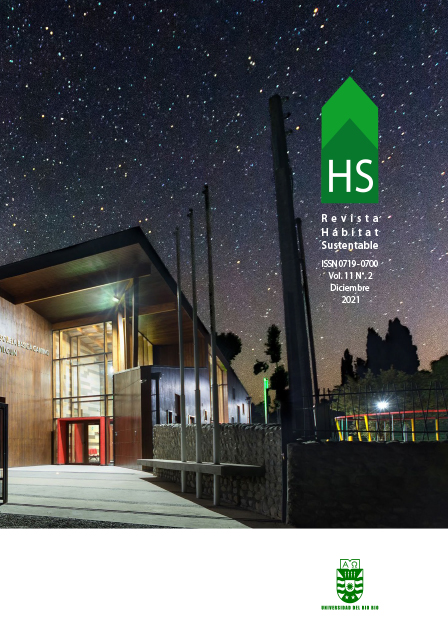CFD simulation of an inclined roof solar chimney
DOI:
https://doi.org/10.22320/07190700.2021.11.02.06Keywords:
solar energy, ventilation, CFD simulationAbstract
In recent years, energy consumption from electrical devices to foster air movement in regions with warm climates has risen, with the resulting negative impact on the environment. The purpose of this paper is to evaluate the performance of a solar chimney used to induce natural ventilation in a closed space, under the weather conditions of the hot humid Mexican climate. For this purpose, CFD simulations were run using the RNG k- ɛ turbulence model and the DO radiation model, considering only natural convection phenomena. The solar chimney performance was evaluated, comparing the results of the simulations with experimental measurements, analysis which showed a good match. Temperatures of up to 46.5%°C in the air within the chimney, and of 77.1°C on the absorption plate, were obtained, results that allow verifying the influence of the heat discharge phenomenon by the natural flotation of air in the chimney.
Downloads
References
AL-KAYIEM, H., K.V. SREEJAYA & GILANI, S. (2014). Mathematical analysis of the influence of the chimney height and collector area on the performance of a roof top solar chimney. Energy and Buildings 68: 305-311.
BASSIOUNY, R. & KORAH, N. (2009). Effect of solar chimney inclination angle on space flow pattern and ventilation rate. Energy and Buildings 41: 190-196.
BOUCHAIR, A. (1994). Solar Chimney for Promoting Cooling Ventilation in Southern Algeria. Building Services Engineering Research and Technology 15: 81-93.
CHEN, Z., BANDOPADHAYAY, P., HALLDORSSON, J., BYRJALSEN, C., HEISELBERG, P. & LI, Y. (2003). An experimental investigation of a solar chimney model with uniform wall heat flux. Building and Environment 38: 893-906.
DE BUEN, O. (2017). El confort en la demanda eléctrica. [En línea]. Recuperado el 26/03/2018 de https://www.energiaadebate.com/blog/2338/
GONZÁLEZ, L & BEELE, A. (2016). Estudio de caracterización del uso de aire acondicionado en vivienda de interés social. Comisión Nacional para el Uso Eficiente de la Energía. [En línea]. Recuperado el 10/10/2017 de https://www.gob.mx/cms/uploads/attachment/file/164221/Conuee_2016_Estudio_Caracterizaci_n_Uso_Aire_Acondicionado_en_Vivienda.pdf
HARRIS, D. & HELWIG, N. (2007). Solar chimney and building ventilation. Applied Energy 84: 135-146.
INEGI. (2018). Encuesta Nacional de Consumo de Energéticos en Viviendas Particulares (ENCEVI) 2018. Instituto Nacional de Estadística y Geografía. Recuperado el 15/07/2020 de https://www.inegi.org.mx/contenidos/programas/encevi/2018/doc/encevi2018_presentacion_resultados.pdf
JIANLIU, X. & WEIHUA, L. (2013). Study on solar chimney used for room natural ventilation in Nanjing. Energy and Buildings 66: 467-469.
KHANAL, R. & LEI, C. (2011). Numerical investigation of the ventilation performance of a solar chimney. ANZIAM Journal 52: 899-913.
LAL, S., KAUSHIK, S. & BHARGAV, P. (2013). Solar chimney: A sustainable approach for ventilation and building space conditioning. International Journal of Development and Sustainability 2(1). ISSN: 2168-8662.
LI, A., JONES, P., ZHAO, P. & WANG, L. (2004) Heat transfer and natural ventilation airflow rates from single-sided heated solar chimney for buildings. Journal of Asian Architecture and Building Engineering 3(2): 233-238. doi: 10.3130/jaabe.3.233
MAHDAVINEJAD, M., & KHAZFOROOSH, S. (2014). Combination of Wind Catcher and Chimney for More Energy Efficient Architectural Buildings. Sustainable Energy, 2(1), 35-38.
MATHUR, J., BANSAL, N., MATHUR, S., JAIN, M. & ANUPMA. (2006). Experimental investigations on solar chimney for room ventilation. Solar Energy 80: 927-935.
NEVES, L. (2012). Chaminé solar como elemento indutor de ventilação natural em edificações. (Tesis Doctoral). Universidade Estadual de Campinas.
SAIFI, N., SETTOU, N., DOKKAR, B., NEGROU, B., & CHENNOUF, N. (2012). Experimental study and simulation of airflow in solar chimneys. Energy Procedia 18: 1289 – 1298.
SALEEM, A., BADY, M., OOKAWARA, S. & ABDEL-RAHMAN, A. (2016). Achieving standard natural ventilation rate of dwellings in a hot-arid climate using solar chimney. Energy and Buildings 133: 360–370.
SÁNCHEZ, E. (2017). Optimización de la fachada de doble piel acristalada con ventilación natural. Metodología de diseño para el análisis de la eficiencia energética del sistema. (Tesis doctoral). Universidad Politécnica de Madrid. España.
SHI, L., ZHANG, G., CHENG, X., GUO, Y., WANG, J. & CHEW, M. (2016). Developing an empirical model for roof solar chimney based on experimental data from various test rigs. Building and Environment 110: 115-128.
SHI, L., ZHANG, G., YANG, W., HUANG, D., CHENG, X. & SETUNGE, S. (2018). Determining the influencing factors on the performance of solar chimney in buildings. Renewable and Sustainable Energy Reviews 88: 223-238.
WANG, L., & LI, A. (2006). A numerical study of vertical solar chimney for enhancing stack ventilation in buildings. In: Proceedings of the 21th conference on passive and low energy architecture. Eindhoven, The Netherlands; pp. 1–5.
YUSOFF, W., SALLEH, E., ADAM, N., SAPIAN, A., & SULAIMAN, M. (2010). Enhancement of stack ventilation in hot and humid climate using a combination of roof solar collector and vertical stack. Building and Environment 45: 2296-2308.
ZHAI, X., DAI, Y. & WANG, R. (2005). Comparison of heating and natural ventilation in a solar house induced by two roof solar collectors. Applied Thermal Engineering 25: 741-757.
Zhang, T., Tan, Y., Yang, H., & Zhang, X. (2016). The application of air layers in building envelopes: A review. Applied Energy 165: 707–734.
Downloads
Published
How to Cite
Issue
Section
License
Copyright (c) 2021 Sandra Rodríguez-Trejo, Víctor Fuentes-Freixanet

This work is licensed under a Creative Commons Attribution-ShareAlike 4.0 International License.
The content of articles which are published in each edition of Habitat Sustentable, is the exclusive responsibility of the author(s) and does not necessarily represent the thinking or compromise the opinion of University of the Bio-Bio.
The author(s) conserve their copyright and guarantee to the journal, the right of first publication of their work. This will simultaneously be subject to the Creative Commons Recognition License CC BY-SA, which allows others to share-copy, transform or create new materials from this work for non-commercial purposes, as long as they recognize authorship and the first publication in this journal, and its new creations are under a license with the same terms.











 Scientific Information Program/Concurso Fondos de Publicación de Revistas Científicas 2018/ Proyecto Mejoramiento de Visibilidad de Revistas UBB (Código:FP180007).
Scientific Information Program/Concurso Fondos de Publicación de Revistas Científicas 2018/ Proyecto Mejoramiento de Visibilidad de Revistas UBB (Código:FP180007).





